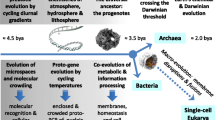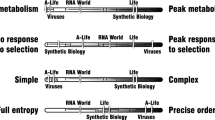Abstract
In this article we address selected important milestones of chemical evolution that led to life. The first such milestone could be achieved by Oparin’s model, which accounts for the early stages of chemical evolution. These occurred at the dawn of development of primitive chemical systems that were pre-RNA. Oparin’s model consists of spontaneous formation of coacervates that encapsulate chemical matter, undergo primitive self-replication, and provide a pathway to a primitive metabolism. We review the experimental updates of his model from our laboratory and discuss types of selection that could have occurred in these primitive systems. Another major milestone in chemical evolution is the transition from abiotic to biotic. This has occurred later, after the RNA world evolved. A controversy of what life is interferes with the efforts to elucidate this transition. Thus, we present various definitions of life, some of which specifically include the requirements and mechanisms for this transition. Self-replication is one of the major requirements for life. In this context we re-examine the question if viruses, which do not have capability to self-replicate, are alive. We draw on philosophy of Hegel, Aristotle, Rescher, Priest, and Fry to guide us in our endeavors. Specifically, we apply Hegel’s law on quantity-to-quality transition to abiotic-to-biotic transition, Aristotle’s philosophy to the definition of life, Priest’s dialetheism to the question if viruses are alive or not, Fry’s philosophy to the beginning of natural selection in chemical evolution, and Rescher’s philosophy to the possible cognitive bias toward simple definitions of life.



Similar content being viewed by others
References
Arrhenius, G. (2002). Short definitions of life. In G. Pályi, C. Zucchi, & L. Caglioti (Eds.), Fundamentals of life (pp. 18–19). New York: Elsevier.
Bergson, H. (1998). Creative evolution (A. Mitchell, Trans.). Mineola, NY: Dover Publications, Inc.
Brack, A. (Ed.). (1998). The molecular origins of life: Assembling pieces of the puzzle. Cambridge: Cambridge University Press.
Carter, J. B., & Saunders, V. A. (2013). Virology: Principles and Applications (2nd ed., pp. 99–100, 109–110, 238). Chichester: Wiley.
Coacervate. https://en.wikipedia.org/wiki/Coacervate. Accessed on June 23, 2015.
Cleland, C. E., & Chyba, C. (2002). Defining ‘life’. Origins of Life and Evolution of the Biosphere, 32, 378–393.
Eldredge, N. (1999). The patterns of evolution. New York: W. H. Freeman and Co.
Engels, F. (1960). Dialectics of nature (pp. 26–34). New York: International Publishers.
Evreinova, T. N., Mamontova, T. W., Karnauhov, V. N., Stephanov, S. B., & Hrust, U. R. (1974). Coacervate systems and origins of life. Origins of Life, 5, 201–205.
Evreinova, T. N., Mel’nikova, E. V., Allakhverdov, B. L., & Karnaukhov, V. N. (1977). Coexistence of coacervate systems with different chemical composiiton. Zhurnal Evolyutsionnoi Biokhimii i Fiziologii, 13, 330–335.
Evreinova, T. N., Mel’nikova, E. V., Pogorelov, A. G., & Allakhverdov, B. L. (1975). Stabilization and coexistence of coacervate systems of different chemical composition. Doklady Akademii Nauk SSSR, 224, 239–241.
Evreinova, T. N., Stefanov, S. B., & Marmontova, T. V. (1973). Structure of coacervate drops in an electron microscope. Doklady Akademii Nauk SSSR, 208, 243–244.
Flammer, L. (2015). Creating coacervates. www.indiana.edu/~ensiweb/lessons/coac.lab.pdf; http://www.indiana.edu/~ensiweb/lessons/coacerv.html. Accessed on June 23, 2015.
Fox, S. W. (1964). Thermal polymerization of amino-acids and production of formed microparticles on lava. Nature, 201, 336–337.
Fox, S. W., & Dose, K. (1977). Molecular evolution and the origin of life. New York: Marcel Dekker.
Fox, S., & Harada, K. (1958). Thermal copolymerization of amino acids to a product resembling protein. Science, 128, 1214.
Fry, I. (2000). The emergence of life on earth: A historical and scientific overview (pp. 66–71). New Brunswick, NJ: Rutgers University Press.
Fry, I. (2011). The role of natural selection in the origin of life. Origins of Life and Evolution of the Biosphere, 41, 3–16.
Gallois, A. (2003). Occasions of identity: The metaphysics of persistence, change, and sameness. Oxford: Oxford University Press.
Gatlin, L. (1972). Information theory and the living system. New York: Columbia University Press.
Gilbert, W. (1986). The RNA world. Nature, 319, 618.
Gladilin, K. L., Orlovsky, A. F., Kirpotin, D. B., & Oparin, A. I. (1978). Coacervate drops as a model for precellular structures. In Origins of life, proceedings of ISSOL meeting, 2nd (pp. 357–362).
Gontier, N. (2012). Applied evolutionary epistemology. In Kairos, Revista de Filosofia & Ciênca (Vol. 4, pp. 1–49). Centro de Filosofia das Ciências da Universidade de Lisboa.
Hazen, R. M. (2005). Genesis: The scientific quest for life’s origins. Washington, DC: Joseph Henry Press.
Hegel, G. W. F. (1975). Logic (W. Wallace, Trans.) (pp. 265–267). New York: Oxford University Press.
Hooper, M. H., & DeBoef, B. (2009). A green multicomponent reaction for the organic chemistry laboratory: The aqueous Passerini reaction. Journal of Chemical Education, 86, 1077–1079.
Horowitz, N. H. (1986). To utopia and back: The search for life in the solar system. New York: H. W. Freeman.
Jalasvuori, M., & Bamford, J. H. (2015). Evolutionary approach to viruses in astrobiology. In V. M. Kolb (Ed.), Astrobiology: An evolutionary approach (pp. 413–420). Boca Raton, FL: CRC/Taylor & Francis Group.
Joyce, G. F., & Orgel, L. E. (2006). Progress toward understanding the origin of the RNA world. In R. F. Gesteland, T. R. Cech, & J. F. Atkins (Eds.), The RNA world (3rd ed., pp. 23–56). Cold Spring Harbor, NY: Cold Springs Harbor Laboratory.
Kauffman, S. S. (1986). Autocatalytic sets of proteins. Journal of Theoretical Biology, 119, 1–24.
Kauffman, S. S. (1993). The origins of order: Self-organization and selection in evolution. New York: Oxford University Press.
Kellert, S. H., Longino, H. E., & Waters, C. K. (Eds.). (2006). Scientific pluralism. Minneapolis, MN: University of Minnesota Press.
Kolb, V. M. (2002). Short definitions of life. In G. Pályi, C. Zucchi, & L. Caglioti (Eds.), Fundamentals of life (p. 39). New York: Elsevier.
Kolb, V. M. (2005). On the applicability of the principle of quantity-to-quality transition to chemical evolution that led to life. International Journal of Astrobiology, 4, 227–232.
Kolb, V. M. (2007). On the applicability of the Aristotelian principles to the definition of life. International Journal of Astrobiology, 6, 51–57.
Kolb, V. M. (2009). On the applicability of the identity problem to astrobiology. In R. B. Hoover, G. V. Levin, A. Y. Rozanov & K. D. Retherford (Eds.), Instruments and methods for astrobiology and planetary missions XII, SPIE (Vol. 7411, 74410U 1–7).
Kolb, V. M. (2010). On the applicability of dialetheism and philosophy of identity to the definition of life. International Journal of Astrobiology, 9(2), 131–136.
Kolb, V. M. (2012). On the laws for the emergence of life from abiotic matter. In R. B. Hoover, G. V. Levin & A. Y. Rozanov (Eds.), Instruments, methods, and missions for astrobiology XV, SPIE (Vol. 8521, 852109 1–8).
Kolb, V. M., & Liesch, P. J. (2008). Abiotic, biotic, and in-between. In R. B. Hoover, G. V. Levin, A. Y. Rozanov & P. C. Davis (Eds.), Instruments, methods, and missions for astrobiology XI, SPIE (Vol. 7097, 70970A).
Kolb, V. M., Swanson, M., & Menger, F. M. (2012). Coacervates and their prebiotic potential. In R. B. Hoover, G. V. Levin & A. Y. Rozanov (Eds.), Instruments, methods, and missions for astrobiology XV, SPIE (Vol. 8521, pp. 85210E, pp. 1–8).
Koonin, E. V. (2012). Defining life: An exercise in semantics or a route to biological insights? Journal of Biomolecular Structure and Dynamics, 29, 603–605.
Liesch, P. J., & Kolb, V. M. (2007). Living strategies of unusual life forms on Earth and the relevance to astrobiology. In R. B. Hoover, F. V. Levin, A. Y. Rozanov & P. C. W. Davies (Eds.), Instruments, Methods, and Missions for Astrobiology X, SPIE (Vol. 6694, 66941F).
Luisi, P. L. (1998). About various definitions of life. Origins of Life and Evolution of the Biosphere, 28, 613–622.
Margulis, L., & Fester, R. (Eds.). (1991). Symbiosis as a source of evolutionary innovation: Speciation and morphogenesis. Cambridge, MA: Massachusetts Institute of Technology.
Mason, S. F. (1991). Chemical evolution: Origins of the elements, molecules and living system. Oxford: Oxford University Press.
Maynard-Smith, J. (1975). The theory of evolution. Harmondsworth: Penguin.
Menger, F. M. (2002). Supramolecular chemistry and self-assembly. PNAS, 99(8), 4818–4822.
Menger, F. M. (2011). Remembrances of self-assemblies past. Langmuir, 27, 5176–5183.
Menger, F. M., Peresypkin, A. V., Caran, K. L., & Apkarian, R. P. (2000). A sponge morphology in an elementary coacervate. Langmuir, 16, 9113–9116.
Menger, F. M., & Sykes, B. M. (1998). Anatomy of a coacervate. Langmuir, 14, 4131–4137.
Miller, S. L. (1953). Production of amino acids under possible primitive earth conditions. Science, 117, 528–529.
Oparin, A. I. (1924). Proiskhozhdenie zhizny. Moscow: Moskovshii Rabochii, Izd.
Oparin, A. I. (1961). Life: Its nature, origin and development. New York: Academic Press.
Oparin, A. I. (1967). The origins of life. In J. D. Bernal (Ed.), Origins of life. London: Weidenfeld & Nicolson.
Oparin, A. I. (1968). Genesis and evolutionary development of life (pp. 101–126). New York: Academic Press.
Oparin, A. I. (1969). Chemistry and the origin of life. Royal Institute of Chemistry (RIC) Reviews, 2, 1–12.
Oparin, A. I. (1994). The origins of life, Translation of 1924 book by Ann Synge, reprinted from Bernal, J. D., Origins of life (pp. 199–234). London: Weidenfeld & Nicolson, 1967; republished in D. W. Deamer & G. R. Fleishaker (Eds.), Origins of life: The central concepts (pp. 31–71). Boston, MA: Jones and Bartlett Publishing.
Oparin, A. I., & Gladilin, K. L. (1980). Evolution of self-assembly of probionts. BioSystems, 12, 133–145.
Pályi, G., Zucchi, C., & Caglioti, L. (Eds.). (2002). Fundamentals of life (pp. 15–55). New York: Elsevier.
Perry, R. S., & Kolb, V. M. (2004). On the applicability of Darwinian principles to chemical evolution that led to life. International Journal of Astrobiology, 3, 45–53.
Popa, R. (2004). Between necessity and probability: Searching for the definition and origins of life (pp. 197–205). Heidelberg: Springer.
Popa, R. (2010). Necessity, futility and the possibility of defining life are all embedded in its origin as a punctuated-gradualism. Origins of Life and Evolution of the Biosphere, 40, 183–190.
Popa, R. (2012). Merits and caveats of using a vocabulary approach to define life. Journal of Biomolecular Structure and Dynamics, 29, 607–608.
Popa, R. (2015). Elusive definition of life: A survey of main ideas. In V. M. Kolb (Ed.), Astrobiology: An evolutionary approach (pp. 325–348). Boca Raton, FL: CRC/Taylor & Francis Group.
Priest, G. (1995). Beyond the limits of thought (pp. 3–8, 56–70, 104–105). Cambridge: Cambridge University Press.
Prigogine, I. (1997). The end of certainty. New York: The Free Press.
Prigogine, I., & Stengers, I. (1984). Order out of chaos. New York: Bantam Books Inc.
Rescher, N. (1999). The limits of science (Revised ed., pp. 46–54). Pittsburg, PA: University of Pittsburgh Press.
Sattler, R. (1986). Bio-philosophy. Berlin: Springer-Verlag.
Schopf, J. W. (Ed.). (2002). Life’s origin: The beginning of biological evolution. Berkeley and Los Angeles: University of California Press.
Schulze-Makuch, D., Guan, H., Irwin, L. N., & Vega, E. (2002). Redefining life: An ecological, thermodynamic, and bioinformatic approach. In G. Pályi, C. Zucchi, & L. Caglioti (Eds.), Fundamentals of life (pp. 169–179). New York: Elsevier.
Szostak, J. W. (2012). Attempts to define life do not help to understand the origins of life. Journal of Biomolecular Structure and Dynamics, 29, 599–600.
Trifonov, E. N. (2011). Vocabulary of definitions of life suggests a definition. Journal of Biomolecular Structure and Dynamics, 29, 259–264.
Villarreal, L. P. (2004). Are viruses alive? Scientific American-American Edition, 291, 100–105.
Villarreal, L. P. (2015). Virolution can help us understand the origin of life. In V. M. Kolb (Ed.), Astrobiology: An evolutionary approach (pp. 421–440). Boca Raton, FL: CRC/Taylor & Francis Group.
Acknowledgments
Thanks are expressed to Wisconsin Space Grant Consortium/NASA for a steady support of our research over a period of many years.
Author information
Authors and Affiliations
Corresponding author
Ethics declarations
Conflict of interest
The author has no conflict of interest.
Rights and permissions
About this article
Cite this article
Kolb, V.M. Origins of Life: Chemical and Philosophical Approaches. Evol Biol 43, 506–515 (2016). https://doi.org/10.1007/s11692-015-9361-4
Received:
Accepted:
Published:
Issue Date:
DOI: https://doi.org/10.1007/s11692-015-9361-4




